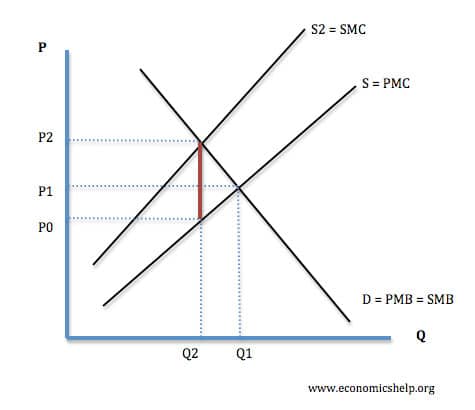
An examination of the advantages and disadvantages of congestion charges:
Some cities, such as London have introduced a congestion charge. The aim of a congestion charge is:
- Reduce congestion. Therefore reduce time wasted and reduce costs for business
- Reduce pollution. Fewer cars will lead to less pollution.
- Make city centres more attractive for pedestrians and cyclists, which will help increase the quality of life.
- Raise revenue. The money from congestion charge can be spent on other forms of public transport and increasing alternatives to driving.
- Make drivers pay the full social cost of driving. Driving in city centres incurs significant external costs on the rest of society. The main external costs include congestion, pollution and accidents. Congestion is estimated to cost the UK economy over £20bn a year in terms of extra costs for business (time wasted) Driving already incurs taxes, most notably, petrol tax. However, petrol tax doesn’t discriminate for where congestion is worst. Therefore, councils could place a congestion charge on driving into a certain area at busy times
- Reduce Journey Time. This is good for business, but also helpful for emergency services in getting to serious injuries quicker.
Diagram of Congestion Tax

A congestion charge shift supply to left and makes drivers pay the SMC (social marginal cost of driving)
Arguments against a Congestion Charge
- Lost Business for firms in the city centre. It is argued that a congestion charge will encourage people to visit out of town shopping centres and lead to a decline in city centres.
- Expensive to Administer. The costs of collecting a congestion charge are much higher than petrol tax. It requires sophisticated technology and chasing up drivers who don’t pay or try to avoid. For smaller cities, the administration costs may be prohibitive.
- Evasion. Since the congestion charge has been introduced, there has been a growth in the number of false number plates and schemes to try to avoid paying the tax (such as setting up false minicab firms)
- Inequality. A congestion charge is regressive as it takes a higher % of income in tax from the poor.
London Congestion Charge
The congestion charge has reduced some of London’s worst traffic problems. People don’t like paying taxes, but neither do people like sitting in a traffic jam. It annoys me how many voters expect solutions to problems without any tax.
- Evidence from TfL suggests that following the introduction of the congestion charge, traffic fell 15% leading to a 30% improvement in journey time. (pdf)
- It was feared that a congestion charge would lead to more congestion in the area surrounding the congestion zone, however, this hasn’t materialised.
- The London Ambulance Service reports a tripling in survival rates from cardiac arrests; it attributes this to better machines and also lower traffic congestion. (link)
- Other reports are more sceptical of the reduction in traffic volumes. However, London has seen a prolonged growth in traffic volumes. A congestion charge may just reduce the growth of traffic volumes.
- The impact on business is debated. However, a study published after the introduction of the charge suggested the impact was mostly neutral, with few businesses feeling it had made even big benefit or damaging loss. (Guardian)
How Effective Will a Congestion Charge Be in Reducing Demand?
If the tax is quite significant, such as £7 per journey, you would expect it to have the effect of reducing demand. However, it is uncertain how much demand will fall by. If demand for driving in this area is inelastic, the higher price will only have a relatively small effect on reducing demand. However, if demand is elastic then there will be a bigger % reduction in demand.
There are various factors which will determine the elasticity of demand.
- Are there alternative modes of transport? e.g. in London, commuters can use the underground, but, in Birmingham, there is no underground system. Therefore a congestion charge may be less effective in Birmingham
- How necessary is it for people to drive in that area? For example, is there good parking on the outskirt of the area? If the main shopping centre is in the zone, people may still need to drive there.
- Over time. Over time the congestion charge may become more effective. i.e. people have time to buy a bike. In the longer term, shops and businesses may relocate outside the congestion charge.
See also:

Travel time is often more important than travel cost…
Thus a charge must be put into place along side measures to reduce road capacity and improve cycling and public transport infrastructures… if only Boris Johnson could understand this…
The charge raises the money required to provide the infrastructure.
Businesses can consolidate deliveries as happens in Freiburg (Germany) and parts of Bristol. Instead of several deliveries a day, a single delivery is made, reducing by up to 70% the delivery vehicles on the street (and illegally blocking cycle lanes and pedestrian pavements)…
Hi,
Could you please tell me what software you used to draw the graph?
Thank you!
microsoft word
Dear Tejvan Pettinger,
Could you send me a more detailed report about effectiveness of London Congestion Charge?
My teacher Mr Turner is not making us do a geography case study and as such we have been advised to use this webpage. I thank you for providing the necessary information to fill out the worksheets he has so kindly provided us with!